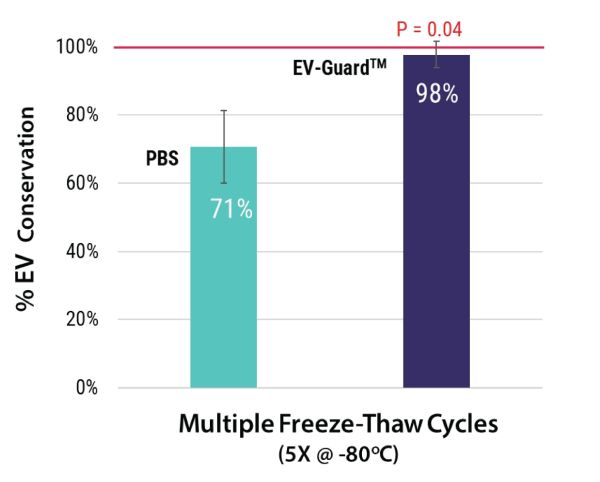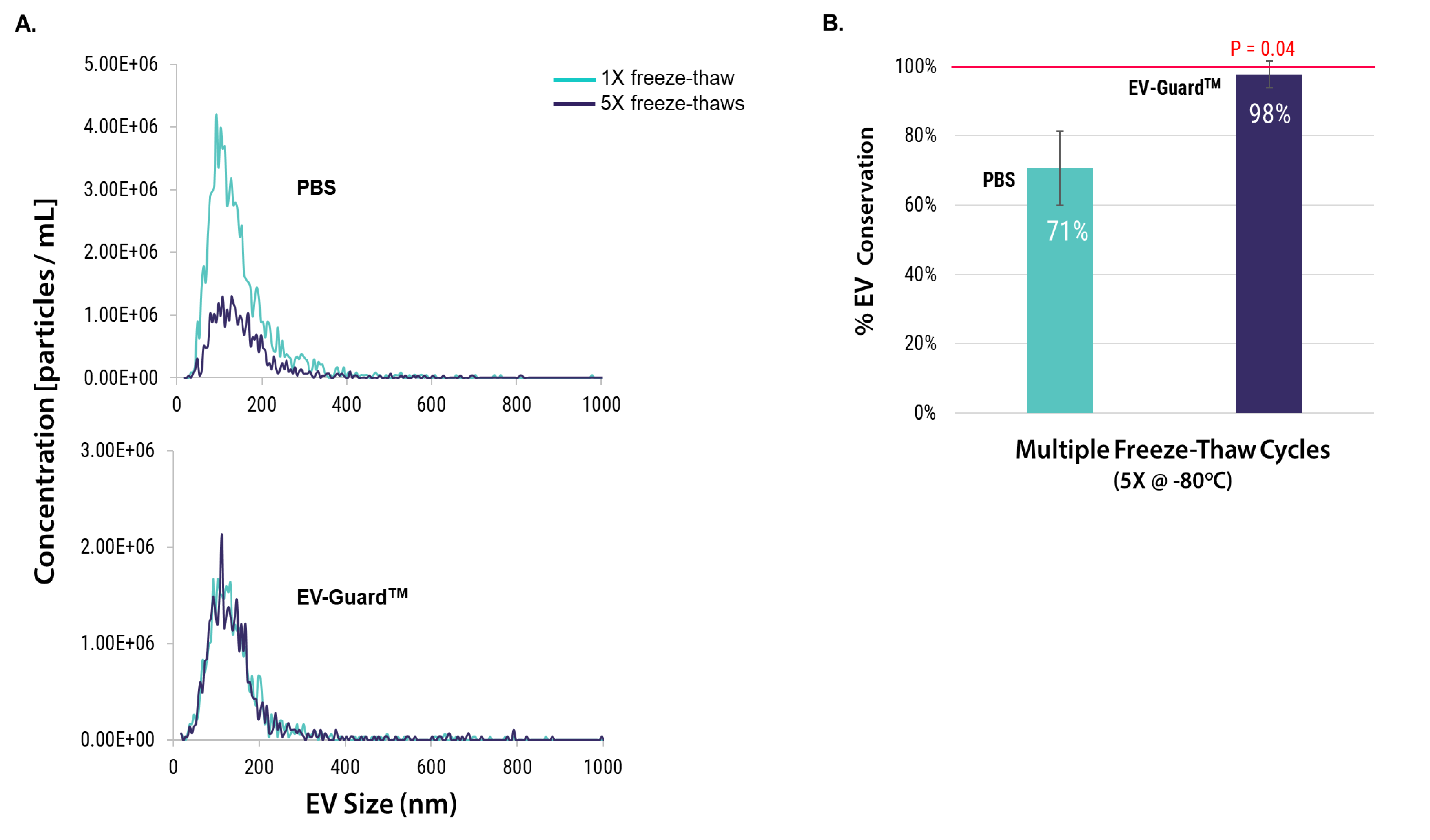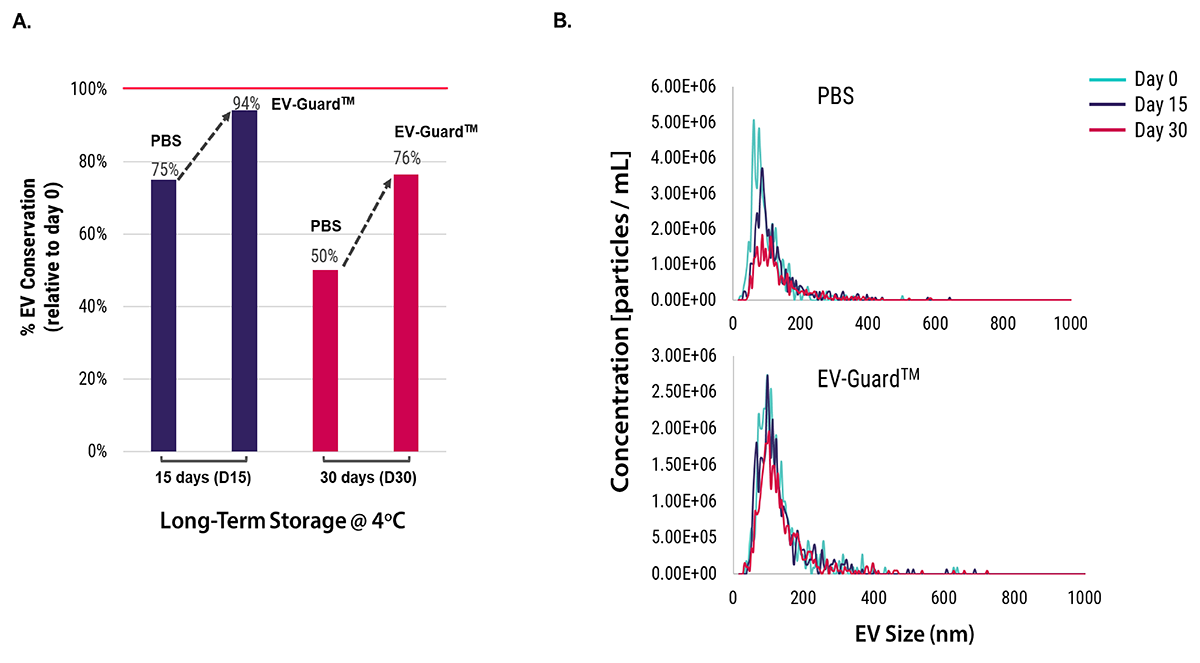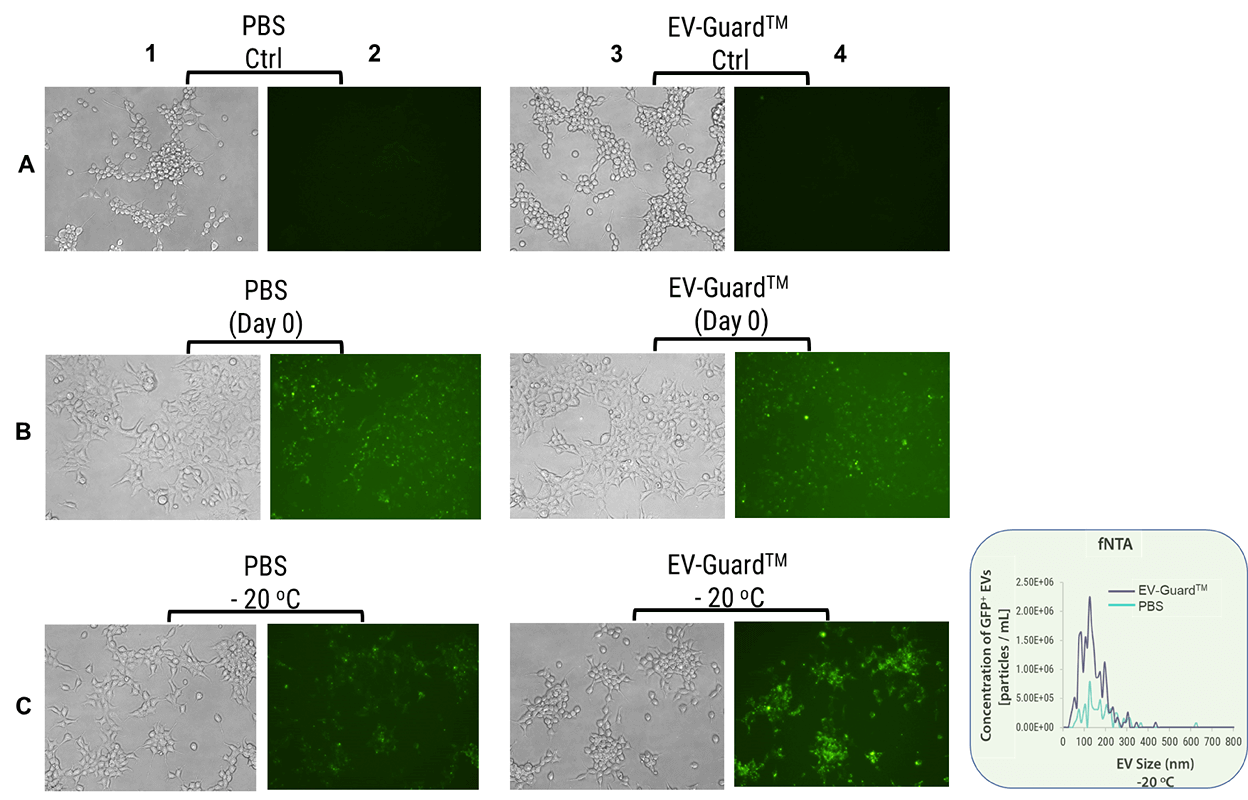EV-GuardTM EV Storage Buffer - 10X concentrated
- Images (1)
| Article Name: | EV-GuardTM EV Storage Buffer - 10X concentrated |
| Biozol Catalog Number: | SBI-EXSBA-10 |
| Supplier Catalog Number: | EXSBA-10 |
| Alternative Catalog Number: | SBI-EXSBA-10 |
| Manufacturer: | System Biosciences |
| Category: | Molekularbiologie |
EV-Guard(TM) EV Storage Buffer (EV-Guard) is an innovative solution designed to safeguard extracellular vesicles (EVs) and maintain their biological activities during storage. With its advanced formulation, EV-Guard effectively preserves the integrity and stability of EVs under various storage conditions, including multiple freeze-thaw cycles. Whether stored at 4°C, -20°C, or -80°C, EV-Guard shields EVs from degradation and ensures their optimal performance.
OverviewThe impact of EV-GuardTM EV storage buffer: Preventing EV degradation, preserving EV integrity, and maintaining functionality: Extracellular vesicles play a crucial role in cell-to-cell communication, carrying various biomolecules such as proteins, lipids, and nucleic acids. They have gained significant interest in research and clinical applications, such as diagnostics, therapeutics, and drug delivery. Preservation of the physical and biological characteristics of EVs is crucial for their use in downstream applications, making storage a key consideration. Typically, EVs are suspended in PBS and stored at -80°C for long-term storage, or at -20°C/4°C for short-term storage. However, these storage conditions may be insufficient to prevent damage to and fragmentation of EVs, which could alter their functional properties. The EV-GuardTM EV Storage Buffer is specifically formulated to prevent EV degradation, ensuring their biological activities are well-maintained. This feature is critical to the success of downstream research and clinical endeavors. With EV-GuardTM, your precious EV samples are well-preserved and ready for use in various applications. Invest in EV-GuardTM EV Storage Buffer today and protect your valuable EV samples for tomorrow’s discoveries.
How It WorksThe buffer is designed in both 1X and 10X concentrated formats to suit the needs for customers who choose to use different EV isolation methods which result in concentrated EV pellets (e.g., by ultracentrifugation, ExoQuick or other precipitation-based methods) or EV suspensions (e.g., by SmartSEC or other size exclusion-based methods). Using the EV-GuardTM EV storage buffer – 1X
Using the EV-GuardTM EV storage buffer – 10X
Supporting DataEV-GuardTM EV Storage Buffer prevents loss of EV particles after multiple freeze-thaw cycles EVs were isolated from HEK293T cell culture media using SBI’s ExoQuick-TC. The samples were stored at -80°C in either PBS or EV-GuardTM before undergoing single and multiple freeze-thaw cycles. The size distribution and concentrations of EV particles were determined by nanoparticle tracking analysis (NTA) (Figure 1A). Compared to the samples stored in PBS, which experienced approximately 30% loss after five freeze-thaw cycles, the EVs stored in EV-GuardTM exhibited 98% conservation (Figure 1B).
Figure 1: The size distribution (A) and the percentage of EV conservation (B) were assessed by NTA following multiple freeze-thaw cycles in both EV-GuardTM buffer and PBS. The data were derived from five independent experiments (n=5), each compared to a single freeze-thaw cycle.
EV-GuardTM EV Storage Buffer minimizes loss and aggregation of EV particles during long-term storage EVs from normal human serum were isolated using SBI’s ExoQuick and stored at 4°C for intervals of 0 days, 15 days, and 30 days. Subsequent analyses were conducted using fluorescent nanoparticle tracking analysis (fNTA). It was observed that EV samples preserved in EV-GuardTM buffer exhibited a higher percentage of EV conservation than samples preserved in PBS after both 15 and 30 days (Figure 2A). Furthermore, the overall sizes of the EVs were consistently maintained during storage in EV-GuardTM, but showed variation when stored in PBS (Figure 2B).
Figure 2: EVs from normal human serum were isolated using SBI’s ExoQuick and stored at 4°C for periods of 0, 15, and 30 days. The percentage of EV conservation (A) and EV size distribution (B) were subsequently analyzed using fluorescent nanoparticle tracking analysis (fNTA).
EV-GuardTM EV Storage Buffer preserves EV functionality and integrity after long-term storage GFP-loaded EVs were isolated from the Xpack CMV-XP-GFP-EF1a-Puro Stable HEK293 Producer Cell Line (Cat. XPAK530CL-1). These EVs were stored in either PBS or EV-GuardTM at -20°C for 1 month before being introduced to HEK293 cells for transfection. The GFP-loaded EVs stored at -20°C in EV-GuardTM demonstrated higher transfection efficiency (Figure 3, C4) than those stored in PBS (Figure 3, C2). Moreover, the number of GFP+ EVs was higher in EV-GuardTM buffer compared to those stored in PBS after 1 month, as analyzed by fluorescent NTA (Figure 3 box).
Figure 3: GFP-loaded EVs were stored in either PBS (columns 1 and 2) or EV-GuardTM (columns 3 and 4) at -20°C for 1 month before being introduced to HEK293 cells for transfection (Row C). Row A represents the negative control (no GFP EVs), while Row B is the positive control (no storage). After 1 month at -20°C, the number of GFP+ EVs was analyzed using fluorescent NTA (as shown in the box to the right). |






